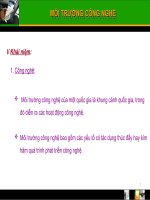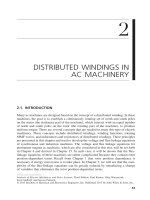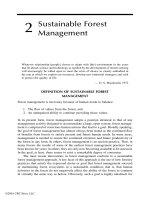Opration management chapter 2 operations strategy in global environment
Bạn đang xem bản rút gọn của tài liệu. Xem và tải ngay bản đầy đủ của tài liệu tại đây (589.91 KB, 66 trang )
Operations
Management
Session 2 –
Operations Strategy in
a Global Environment
© 2008 Prentice Hall, Inc.
2–1
Learning Objectives
When you complete this chapter you
should be able to:
1. Define mission and strategy
2. Identify and explain three strategic
approaches to competitive
advantage
3. Identify and define the 10 decisions
of operations management
© 2008 Prentice Hall, Inc.
2–2
Learning Objectives
When you complete this chapter you
should be able to:
4. Identify five OM strategy insights
provided by PIMS research
5. Identify and explain four global
operations strategy options
© 2008 Prentice Hall, Inc.
2–3
Global Strategies
Boeing – sales and production are
worldwide
Benetton – moves inventory to stores
around the world faster than its
competition by building flexibility into
design, production, and distribution
Sony – purchases components from
suppliers in Thailand, Malaysia, and
around the world
© 2008 Prentice Hall, Inc.
2–4
Global Strategies
Volvo – considered a Swedish company
but it is controlled by an American
company, Ford. The current Volvo S40 is
built in Belgium and shares its platform
with the Mazda 3 built in Japan and the
Ford Focus built in Europe.
Haier – A Chinese company, produces
compact refrigerators (it has one-third of
the US market) and wine cabinets (it has
half of the US market) in South Carolina
© 2008 Prentice Hall, Inc.
2–5
Some Multinational
Corporations
Company
Home
Country
% Sales
Outside
Home
Country
% Assets
Outside
Home
Country
Citicorp
NA
USA
34
46
ColgateNA
Palmolive
USA
72
63
Dow
NA
Chemical
USA
60
50
Gillette
NA
USA
62
53
© 2008 Prentice Hall, Inc.
% Foreign
Workforce
2–6
Some Multinational
Corporations
Company
Home
Country
% Sales
Outside
Home
Country
% Assets
Outside
Home
Country
ICI
NA
Britain
78
50
Nestle
97
Switzerland 98
95
Philips
82
Electronics
Netherlands 94
85
Siemens
38
Germany
51
NA
Unilever
Britain &
95
70
© 2008 Prentice Hall, Inc.
% Foreign
Workforce
2–7
Some Boeing Suppliers (787)
Firm
Latecoere
Labinel
Dassault
Country
France
France
France
Messier-Bugatti
Thales
France
France
Messier-Dowty
Diehl
France
Germany
© 2008 Prentice Hall, Inc.
Component
Passenger doors
Wiring
Design and
PLM software
Electric brakes
Electrical power
conversion system
and integrated
standby flight display
Landing gear structure
Interior lighting
2–8
Some Boeing Suppliers (787)
Firm
Cobham
Rolls-Royce
Smiths Aerospace
Country
UK
UK
UK
BAE SYSTEMS
Alenia Aeronautics
UK
Italy
Toray Industries
Japan
© 2008 Prentice Hall, Inc.
Component
Fuel pumps and valves
Engines
Central computer
system
Electronics
Upper center
fuselage &
horizontal stabilizer
Carbon fiber for
wing and tail units
2–9
Some Boeing Suppliers (787)
Firm
Fuji Heavy
Industries
Kawasaki Heavy
Industries
Country
Japan
Component
Center wing box
Japan
Teijin Seiki
Mitsubishi Heavy
Industries
Chengdu Aircraft
Group
Hafei Aviation
Japan
Japan
Forward fuselage,
fixed section of wing,
landing gear well
Hydraulic actuators
Wing box
China
Rudder
China
Parts
© 2008 Prentice Hall, Inc.
2 – 10
Some Boeing Suppliers (787)
Firm
Korean Aviation
Saab
© 2008 Prentice Hall, Inc.
Country
South
Korea
Sweden
Component
Wingtips
Cargo access doors
2 – 11
Reasons to Globalize
Reasons to Globalize
Tangible 1. Reduce costs (labor, taxes, tariffs, etc.)
Reasons 2. Improve supply chain
3. Provide better goods and services
4. Understand markets
Intangible 5. Learn to improve operations
Reasons 6. Attract and retain global talent
© 2008 Prentice Hall, Inc.
2 – 12
Reduce Costs
Foreign locations with lower wage
rates can lower direct and indirect
costs
Maquiladoras
World Trade Organization (WTO)
North American Free Trade
Agreement (NAFTA)
APEC, SEATO, MERCOSUR
European Union (EU)
© 2008 Prentice Hall, Inc.
2 – 13
Improve the Supply Chain
Locating facilities closer to
unique resources
Auto design to California
Athletic shoe production to China
Perfume manufacturing in France
© 2008 Prentice Hall, Inc.
2 – 14
Provide Better Goods
and Services
Objective and subjective
characteristics of goods and
services
On-time deliveries
Cultural variables
Improved customer service
© 2008 Prentice Hall, Inc.
2 – 15
Understand Markets
Interacting with foreign customers
and suppliers can lead to new
opportunities
Cell phone
design from
Europe
Cell phone
fads from
Japan
Extend the product life cycle
© 2008 Prentice Hall, Inc.
2 – 16
Learn to Improve Operations
Remain open to the free flow of
ideas
General Motors partnered with a
Japanese auto manufacturer to
learn
Equipment and layout have been
improved using Scandinavian
ergonomic competence
© 2008 Prentice Hall, Inc.
2 – 17
Attract and Retain Global
Talent
Offer better employment
opportunities
Better growth opportunities and
insulation against unemployment
Relocate unneeded personnel to
more prosperous locations
Incentives for people who like to
travel
© 2008 Prentice Hall, Inc.
2 – 18
Cultural and Ethical Issues
Cultures can be quite different
Attitudes can be quite different
towards
© 2008 Prentice Hall, Inc.
Punctuality
Lunch breaks
Thievery
Bribery
Environment
Intellectual
property
Child labor
2 – 19
Developing Missions and
Strategies
Mission statements tell an
organization where it is going
The Strategy tells the
organization how to get there
© 2008 Prentice Hall, Inc.
2 – 20
Merck
The mission of Merck is to provide
society with superior products and
services - innovations and solutions
that improve the quality of life and
satisfy customer needs - to provide
employees with meaningful work and
advancement opportunities and
investors with a superior rate of return
Figure 2.2
© 2008 Prentice Hall, Inc.
2 – 21
Strategic Process
Organization’s
Mission
Functional
Area Missions
Marketing
© 2008 Prentice Hall, Inc.
Operations
Finance/
Accounting
2 – 22
Strategy
Action plan to
achieve mission
Functional areas
have strategies
Strategies exploit
opportunities and
strengths, neutralize
threats, and avoid
weaknesses
© 2008 Prentice Hall, Inc.
2 – 23
Strategies for Competitive
Advantage
Differentiation – better, or at least
different
Cost leadership – cheaper
Response – rapid response
© 2008 Prentice Hall, Inc.
2 – 24
Competing on
Differentiation
Uniqueness can go beyond both the
physical characteristics and service
attributes to encompass everything
that impacts customer’s perception of
value
Safeskin gloves – leading edge products
Walt Disney Magic Kingdom –
experience differentiation
Hard Rock Cafe – dining experience
© 2008 Prentice Hall, Inc.
2 – 25









